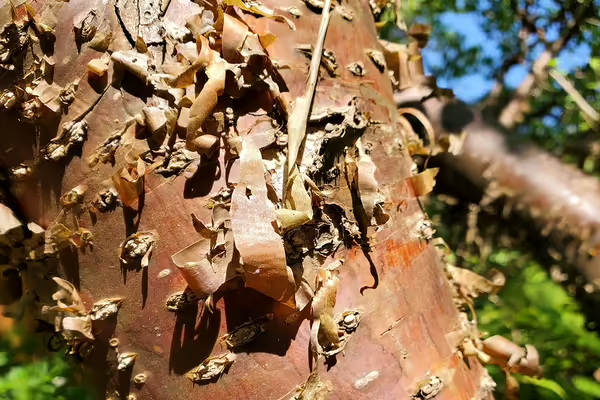
URBANA, Ill. – With bright colors and interesting shapes, unusual tree and shrub bark can add visual interest to winter landscapes. Many types of bark become more distinctive and sought after during winter months. Selecting trees based on their bark can bring four seasons of visual interest to your landscape.
How bark looks, whether from the interior or exterior, is exciting for both avid naturalists and those who can’t tell an oak tree from an apple tree. Barks come in many distinctive types - smooth, peeling in strips, exposed lenticles, vertical cracks or seams, plates, and vertical strips, and ridges and furrows. These eye catching textures are why people select trees and shrubs specifically for their winter interest.
Tree bark is not static, but changes throughout the plant’s lifecycle. As time ages the bark of the tree, it becomes thicker. Texture can be described by different levels of coarse, medium, or fine. This texture is often associated with the size of limbs or characteristics of branching. Most plants are a medium texture, but bark becomes more coarse as deeper furrows are compared to smooth bark.
Consider size when selecting trees and large shrubs as the mature size may take up considerable space in the yard. Hardiness is another factor to consider, although some landscapes may offer a microclimate to accommodate some species on the border of hardiness.
Another method of catching the eye is to add color to the landscape with bright stems or bark. Stems can carry a variety of colors: bronze, brown, red, orange, and yellow. Cultivar selection is a great way to find the variation needed in the landscape.
If you’re interested in trees or shrubs with winter interest dogwoods are a great option. Dogwood shrubs come in a variety of colors. Their stems can be propagated as hardwood cuttings throughout their dormancy stage. Dogwood trees can also have a very interesting bark.
While colored bark or stems provide an immediate visual show, exfoliating bark often reveals colors below the bark from species like paperbark maple (Acer griseum) or river birch (Betula nigra). Exfoliating or peeling bark in trees like shagbark hickory can provide beneficial roosting habitat for bats.
The sheen of the bark can be another feature sought after. Trees can have an especially shiny bark in the winter and highlight the sun striking the bark.
Site analysis is one of the most critical aspects of selecting plants as winter will be influential on survival depending on its severity. Examine the hardiness of trees and shrubs and select plants appropriately.
For more research-based information on tree care, connect with your local Illinois Extension county office at go.illinois.edu/ExtensionOffice.
ABOUT EXTENSION: Illinois Extension leads public outreach for University of Illinois by translating research into action plans that allow Illinois families, businesses, and community leaders to solve problems, make informed decisions, and adapt to changes and opportunities.
PHOTO ACCESS: The photo in this article is available to download for media use. Tree barks come in many distinctive types - smooth, peeling in strips, exposed lenticles, vertical cracks or seams, plates and vertical strips, and ridges and furrows. This Manchurian Striped Maple tree has eye-catching vertical lines. Photo: Sarah Vogel, University of Illinois Extension.